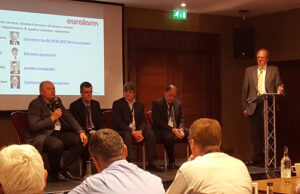
The presenters (L-R): Lance Ruetimann of Siemens, John Battersby from Sunfish Services, Mike Snelling of Hilson Moran, Alex Carmichael of SSAIB and Martin Harvey, FIA.
It is estimated that around 98% of all industry standards are written about technology not services so it was no surprise that a major focus of the recent Euralarm Symposium 2017 was the new service standard EN 16763:2017 which the organisation felt was essential for reaching a high quality and equal service level for fire safety and security systems across Europe.
Speaking at the event about the development of the standard, Lance Ruetimann, Senior Manager Industry Affairs at Siemens, said that to make Europe a strong, viable, economical geographical area it was necessary to bring some aspects into the cross border movement of not just goods but also services: “We made this possible by initiating within the directive certain parameters that defined what the industry should or should not do. This is one of the initiatives that brought up the idea of developing a standard across Europe. The work began in 2011. In 2016 we had 97% of all voters on the standard accepting it as an EN.
“The standard covers all aspects of service not just maintenance. It begins with the planning phase and goes through the whole breadth of services,” he explained. “We are looking at engineers, installers and those commissioning, verifying and maintaining the equipment. We are looking at competencies, knowledge and skills of the involved staff; there are people that are identified within the organisations with responsibilities defined within the standard and this is the area we are moving into.”
Commenting on the EN 16763:2017 and what it means for installers, John Battersby, MD at Sunfish Services, said: “The launch of the new service standard coupled with the FIA training programme launched last week are probably both the most significant steps regarding the installation of fire alarm systems in the UK in the last 15 years and I believe that the success of the schemes will benefit the industry as a whole and I encourage all to support them.”
Alex Carmichael, Chief Executive of SSAIB, concluded the presentations by saying that it is important that the standard is developed and aligned across the EU and that the first version of the standard may well need more “meat” going forward: “We all agree that a level playing field is a good idea, but there are challenges ahead.”

